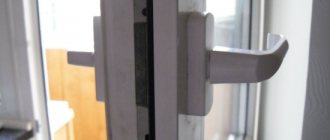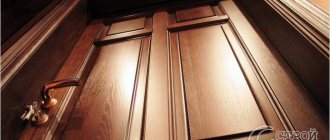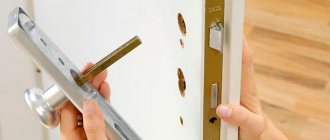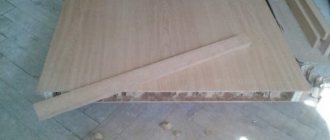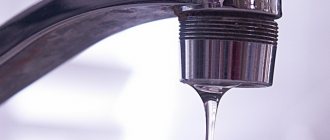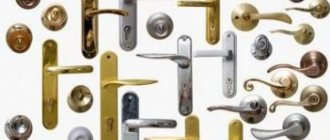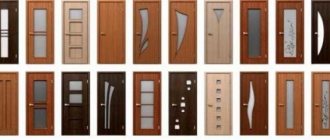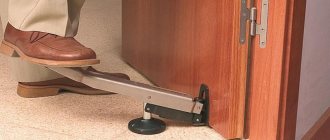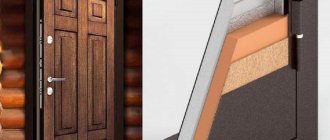Some are content with an arch, while others choose an interior door. The second option provides sound insulation, eliminates drafts and makes staying in the room more comfortable. But during the operation of door structures, various problems often arise. It often happens that the sash gets jammed. This is quite a difficult situation. If an interior door is jammed, not every owner knows what to do. There are different options for solving the problem from the outside and from the inside yourself.
Features of using magnetic latches and locks
A magnetic lock has virtually no rubbing metal gears or spring-loaded latches. Therefore, the lock can be used not only for interior door structures, but also for arranging access to a balcony or veranda.
The design of the lock is very simple, and installing it on an interior door is often not difficult. Most magnetic drive models are produced in the same dimensions as older mechanical locking systems. Therefore, if the interior door already has a cut-out groove or niche for a mortise body, in order to replace the old mechanics with a new magnetic version, it is enough to dismantle the old mechanism and install a new one, with a strike plate.
Disadvantages of magnetic locks for interior doors
Magnetic locks, despite radical modifications and significant design updates, remain largely a mechanical device. Therefore, when installing and replacing the mechanism, do not use adhesives or “tight” fits, which make the structure non-removable.
Even branded lock models are not absolutely faultless in operation, and this installation method can simply destroy the device. It’s even worse if, due to the jamming of the magnet, it will be impossible to disassemble the fixing part without destroying the interior door.
In addition, it is worth remembering the specific properties of the magnet, and there are two of them installed in the locking mechanism, and at the level of a person’s belt or hand. The magnetic field operates 24 hours a day, so it is capable of collecting any magnetic materials on the surface of the door leaf, from the smallest metal dust to paper clips and needles, metal cutlery that accidentally finds itself within the reach of the magnet.
Manufacturers have incorporated a curious property into the design of the lock: already at a distance of 10-15 cm, the bolt magnet begins to interact with the field of the strike plate. As a result, the mechanism attracts the canvas and works like a door closer. This property is useful unless the lock is opened with a key, in which case there is a considerable probability of the doors slamming even in the absence of a draft.
Cheap models do not have a rod or a door leaf position sensor, so when pulled, the bolt may come out of the pencil case, and at the moment of closing, the entire mass of the door leaf will hit the magnet. Any magnets do not withstand shock very well and break easily.
New models of locking devices
In addition to conventional magnetic locks, two more types of devices can be used for interior doors - the so-called reverse action lock and an electromagnetic controlled mechanism.
In the first case, the locking mechanism works like a classic latch. The magnets of the crossbar and the strip do not attract, but repel. To close the door, you need to press the magnetic bolt with the handle, and after releasing the rod enters the striker and remains in an unloaded state the entire time the door is closed. The advantages of the design are the absence of the finishing effect described above.
Magnetic lock for interior doors
Traditional locks have an inherent problem - in order to close and lock the door leaf, a mechanism is used that prevents the handle from turning or the key from rotating into the horizontal movement of the bolt. Dust, natural wear and degeneration of the lubricant render the lock unusable. To get rid of such problems, instead of mechanics, they use magnetic locks for interior doors. Moreover, the cost of such a miracle lock is not much more than ordinary mechanics.
Common breakdowns
If the installation is not carried out according to the rules, in violation, repair of electromagnetic locks will be required. This is done by experienced craftsmen, who also adjust the products. Repair of magnetic locks can be complete or partial. It is carried out in the following cases:
- the magnet malfunctioned;
- the doors do not close tightly;
- the lock does not recognize all the keys, or interruptions in the operation of the controller are noticed;
- There are interruptions in the supply of electric current, which lead to disruption of work processes.
The most common cause of malfunction is a broken adapter. Repair of a magnetic lock is carried out in the following cases:
- deformations of the mounting angle have occurred;
- there were problems with fixing the plate;
- the fastening has become loose;
- the lock is too far from the plate, making it difficult to close the doors, and rust may appear;
- increased magnet attraction, which makes opening difficult.
- Changes in the electrical network can damage the fuses located in the unit.
Operating principle of a magnetic lock for interior doors
The basic principle of progress - “to surprise and simplify” is clearly demonstrated in the design of new generation locking devices. A magnetic door lock works on the same principle as the long-known magnetic latches for cabinets:
- The locking device is based on two permanent magnets. One is fixed on the strike plate installed on the door hatch, the second in the form of a movable bolt is located in the lock case of the interior door;
- To open the lock, just turn the handle on the interior door and disconnect the magnets.
When the door is closed, the distance between the magnets is reduced, the stationary element attracts and fixes the movable bolt and securely holds the interior door until the lock is unlocked;
As soon as the door opens, the distance between the magnetic elements increases sharply, the interaction force drops to zero, and the movable part of the lock returns to its place. Magnetic latches for interior doors work on the same principle. But, unlike locks, latches do not have latches.
Latch installation
Installation of the magnetic latch on the door must be carried out in accordance with the attached instructions. This will ensure correct operation and increase the service life of the mechanism.
In general, the mortise magnetic latch is installed according to the following scheme:
- Markings are applied to the door leaf. To do this, you can use a regular tape measure, measuring the main parameters of the latch, or a special template, if it is included in the mechanism;
Applying markings to the door leaf using a template
- in the marked area, a niche is drilled for the body of the device equipped with magnets, and holes for attaching the handle and fixing bolts;
Drilling holes for fixing the latch and handle
- the latch is fixed to the door leaf;
- the handle is fixed;
Attaching the handle and locking mechanism
- An area for mounting the strike plate is marked on the door frame. For correct marking, it is more advisable to use a marker that is applied to the retractable part of the device. When the latch is closed, a smooth and clear mark is imprinted on the door leaf;
- the tree is excavated to install the striker;
- the bar is fixed with fasteners;
Fixing the strike plate on the door frame
- The functionality of the magnetic latch is checked. If necessary, adjustments are made to the main elements.
How to install a magnetic latch with an additional lock, watch the video.
Magnetic latches do their job well, but to make the room more secure, an additional lock needs to be installed. When choosing a latch, special attention is paid to the type of device and the manufacturer.
Advantages of magnetic lock systems for interior doors
The use of magnets does not make the lock particularly convenient, but it has undeniable advantages over the old mechanical model:
- Significant simplification of the design. The use of magnets made it possible to get rid of the main problem of all locks - the supporting spring, due to which the reliability of the mechanism increased by an order of magnitude;
- The appearance of the locking mechanism for interior doors has been significantly transformed and improved. The protruding part of the lock pawl has disappeared, making it possible to hide the device completely in the door leaf;
- The opening of interior doors became almost silent.
Features of using magnetic latches and locks
A magnetic lock has virtually no rubbing metal gears or spring-loaded latches. Therefore, the lock can be used not only for interior door structures, but also for arranging access to a balcony or veranda.
The design of the lock is very simple, and installing it on an interior door is often not difficult. Most magnetic drive models are produced in the same dimensions as older mechanical locking systems. Therefore, if the interior door already has a cut-out groove or niche for a mortise body, in order to replace the old mechanics with a new magnetic version, it is enough to dismantle the old mechanism and install a new one, with a strike plate.
Disadvantages of magnetic locks for interior doors
Magnetic locks, despite radical modifications and significant design updates, remain largely a mechanical device. Therefore, when installing and replacing the mechanism, do not use adhesives or “tight” fits, which make the structure non-removable.
Even branded lock models are not absolutely faultless in operation, and this installation method can simply destroy the device. It’s even worse if, due to the jamming of the magnet, it will be impossible to disassemble the fixing part without destroying the interior door.
In addition, it is worth remembering the specific properties of the magnet, and there are two of them installed in the locking mechanism, and at the level of a person’s belt or hand. The magnetic field operates 24 hours a day, so it is capable of collecting any magnetic materials on the surface of the door leaf, from the smallest metal dust to paper clips and needles, metal cutlery that accidentally finds itself within the reach of the magnet.
Manufacturers have incorporated a curious property into the design of the lock: already at a distance of 10-15 cm, the bolt magnet begins to interact with the field of the strike plate. As a result, the mechanism attracts the canvas and works like a door closer. This property is useful unless the lock is opened with a key, in which case there is a considerable probability of the doors slamming even in the absence of a draft.
Principle of operation
The principle of operation is based on the physical attraction of magnetic materials (bar) to a source of constant magnetic field (magnet). Magnetic materials are alloys of iron with other metals. Permanent magnets are made from ferromagnetic alloys. The castings are exposed to a strong magnetic field, causing them to become magnetized, becoming a source of constant attraction.
The magnetic field acts at a short distance (5-25 mm), so the blade must be brought close enough to the bar.
Attention! Critics of magnetic clamps often claim that over time, the magnet supposedly loses its properties. Engineering tests have demonstrated that the field reserve in a modern magnet will last for 30-50 years. The door will probably have to be replaced.
The magnet is little affected by ambient temperature and humidity. The absence of moving parts operating under load ensures high reliability, low wear, and long product life.
Opening options: remove the interior door from its hinges, key lock and others
In an unexpected situation, you may need to open an interior door without a key, but people often cannot perform these actions because they do not know how to act correctly. There is not always time and money to call a specialist who is able to help.
Often, interior door systems are equipped with simple mechanisms, and opening them using improvised means is not difficult, and knocking out the door leaf or breaking the lock should only be done as a last resort. To begin with, you can use a few simple recommendations and try to solve the problem yourself with minimal material damage, without calling the experts.
Why is it better to contact us?
- The technicians working for us are professionals, they know how to fix complex breakdowns, and for whom there are no insurmountable tasks.
- We will respond quickly to your call because we know how important time is to you, especially if every second counts.
- We have a set of necessary tools, locks, etc.
- You will receive a full guarantee of up to 3 years for the work performed, which is documented.
- The prices will please you. When placing an order, the visit of the master is free, the price only includes the work and the price of the materials used.
Reasons for the situation
To understand what and how to open an interior door that is blocked, it is necessary to identify the reason that provoked the occurrence of such a situation. The door leaf may not open in the usual way in the following cases:
- the locking latch has moved or is jammed;
- igniter tongue located in the locking mechanism (not retracted from the strike plate);
- there is a key left in the keyhole on the other side of the locking device, which prevents you from opening the lock;
- breakdown of the button mechanism;
- the key broke off, part of it remained in the keyhole and does not allow opening the device;
- the lock mechanism is broken;
- accidentally (due to a draft, a child's prank, etc.) the interior door slammed shut, while the locking mechanism is working, but the key to it is lost.
Electromagnetic devices
These systems require knowledge of electrical engineering because they are connected to the network. Faults are divided into two categories: mechanical and electrical. The first type is determined by the naked eye. This could be a clogged magnet or a misaligned magnet. These breakdowns are easy to fix yourself. But if the failure is of the second type, it means that the electrical part has failed. Possible reasons:
- a burnt coil in the magnet, which happens extremely rarely, requires replacing the part;
- the contact that supplies voltage to the coil does not respond;
- the button is broken - if it jams to open, then the circuit will remain open;
- breakdowns in places where there are adhesions or twists - corrosion easily forms here.
Electromagnetic locks
Opening options
The method that should be used to solve this situation directly depends on the locking hardware used in the door structure. You can try to open different locks in different ways. Some complex mechanisms should not be tackled; it is better to immediately call a specialist, and he will open the interior doors using a special tool. But most often, simple door components are installed on the interior panels.
Remove from hinges
A fairly common and easiest way to open an interior door system is to remove the door leaf from the hinges. This option is only possible if you are inside the room, when this fittings are in the access zone. If there is sufficient distance between the leaf and the frame, the door can be easily removed.
For internal systems, simple card loops are most often used, which are sometimes equipped with removable decorative plugs. By unscrewing this element, you can pull out the pin, and the door is simply removed from the opening.
Key lock
When the locking mechanism is additionally equipped with a cylinder for locking with a key, then in this version you can open the interior door lock in the following ways:
- Sometimes you can get rid of a slammed door by pulling the door handle hard several times. In a simple and loose mechanism, the bolt can bounce off on its own with a little physical force.
- You can try to open the lock with a similar key. Some locking mechanisms operate from several similar keys, and not just from those included in the kit.
- Sometimes the lock is turned by a paper clip, a knitting needle, a nail file, or various other thin objects. An improvised master key is inserted into the cylinder and turned, trying to move the levers or pins away. The process requires some skill and accuracy.
- If all else fails, then you can use one of the relatively harmless options and try to remove the lock. Using a screwdriver (file, ruler, knife, etc.), unscrew all visible screws, then remove the handles and decorative trims. Having gained access to the locking mechanism, you need to try to turn it. The cylinder may have to be drilled out.
How to open a jammed door mechanism?
In order not to find yourself in a sticky situation when there is no way to get into the room and you need to urgently decide what to do, you need to choose high-quality locks and door handles. Usually the difference between low-quality fittings and normal ones is not that great. If the mechanism fails, especially at the wrong moment, the main thing is not to panic, not to try to knock down the door, but to determine the cause of the blockage and try to eliminate it.
To do this, use a Phillips screwdriver to unscrew the fasteners holding the lock cover and try to turn the jammed mechanism. If the actions are unsuccessful, they try to open it with one of the objects at hand.
Suitable for this:
- a plastic card;
- a nail file, but provided that it is durable;
- knife with a thin blade;
- ruler;
- spoke;
- hairpin;
- paperclip and other similar items.
- To open a lock with a pin, it is broken into two halves: one is placed inside the lock, and the pins are turned with the other. When the pin inserted into the lock turns, the door will open.
- The next method is to remove the door from the hinges if they are in immediate access. It is enough to lift the leaf or unscrew the screws holding the hinges on the door frame.
- The third way is to disassemble the locking mechanism by unscrewing all the screws, knocking out the cylinder or drilling it out with a screwdriver.
The most extreme ways to open the door:
- knocking out - for safety, place a towel under the shoulder;
- cutting down the latch if there is a gap between the canvas and the box;
- removing loops with a hacksaw;
- breaking with a crowbar by pressing on the canvas until it opens;
- removing the trim from the striker side, then removing the metal trim.
Required Tools
In order to open interior doors without a key, you may need the following tool:
- flat and Phillips screwdrivers;
- hammer;
- pry bar, chisel;
- pliers;
- angle grinder (grinder);
- hacksaw for metal.
If it is not possible to use such tools, then you can use any available means. A straightened paper clip, knitting needle, nail file, or other long metal object will work to open the small round keyhole.
Preventive measures
To avoid such situations, a number of preventive measures need to be taken:
- The locking mechanisms on the doors should be well looked after (carry out routine repairs, check their functionality and lubricate them on time).
- Jamming devices should be replaced immediately.
- Have a spare set of keys for all doors. Provide them with tags.
- Do not install complex locking mechanisms on doors unless necessary. Sometimes you can give preference to simple bolts, latches and latches (especially if there are small children in the family).
- It is recommended to purchase locks that are equipped with devices for emergency door opening.
Timely preventive measures can eliminate unnecessary problems with interior doors.
